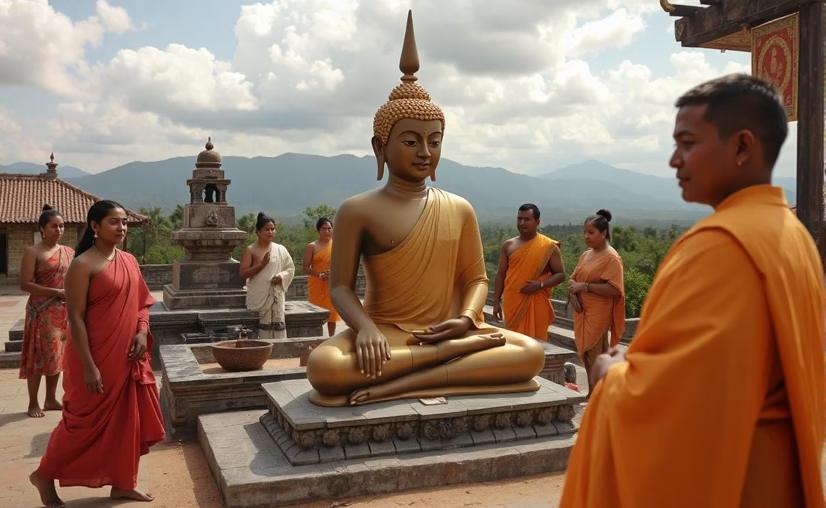
Culture in Buddhist History: The Confluence of Religion and Society
Buddhist history represents a blend of religious teachings and social practices that incorporate wisdom and compassion into artistic expression and ethical and social customs.
The intersection of religion and society within Buddhist history originates from the teachings of Gautama Buddha who lived in the 5th century BCE. Wisdom and compassion became embedded into diverse societies through the dynamic interactions between art, ethics, literature and social structures. Studying Buddhist heritage I see how this tradition from ancient India to contemporary global communities builds harmonious spiritual depth that continues to resonate throughout history.
The Foundations of Buddhist Culture
The Pali Canon recorded the Four Noble Truths and Eightfold Path as the foundation of Buddhism’s cultural influence by the 1st century BCE. Through teachings focused on mindfulness and non-violence Buddhism successfully brought spiritual values into the fabric of societal norms. Scholar Peter Harvey emphasizes Buddhism’s flexibility which enables it to merge with indigenous traditions while preserving its foundational elements.
Core Cultural Values
- Compassion (Karuna): Encourages empathy and kindness.
- Wisdom: Understanding the impermanent nature of existence and selflessness directs individuals toward ethical behavior.
- Community: Sanghas and lay groups foster social cohesion.
Art and Architecture: Cultural Expressions
Artistic expressions in Buddhist culture flourished through majestic stupas such as Sanchi from the 3rd century BCE and intricate cave temples like Ajanta that depicted spiritual stories. The 1st century CE saw Gandharan sculptures merge Greek and Indian artistic traditions to create a humanized representation of the Buddha. Researchers from the Journal of Indian Art History published in 2020 discovered that more than 10,000 Buddhist artworks are still in existence today as expressions of spiritual devotion. The World Heritage Sites designation from UNESCO includes the Sanchi and Ajanta locations.
Artistic Contributions
- Stupas: Sanchi’s carvings depict Jataka Tales, teaching ethics.
- Sculptures: Mathura’s Buddha icons convey serenity.
- Mandala Art: Tibetan designs enhance meditation.
Learn more about Buddhist Art and Culture through our article.
Ethical Practices and Social Structures
The Five Precepts and Vinaya provided the foundation for Buddhist ethics which then structured societal behavior. Lay Buddhists practiced non-violence and generosity while monastic life required monks to follow strict monastic codes. According to British Museum records the edicts of Emperor Ashoka from the 3rd century BCE which survive through more than thirty inscriptions encouraged societal tolerance and welfare practices. According to a 2021 study published in the Journal of Buddhist Ethics Buddhism played a key role in diminishing social hierarchies.
Social Impacts
- Inclusivity: Open to all castes, challenging rigid norms.
- Welfare: Ashoka’s hospitals and schools reflected compassion.
- Festivals: Vesak united communities in celebration.
Our article on Ashoka’s Contribution examines his historical impact.
Literature and Philosophy in Buddhist Culture
The works of Buddhist literature which feature the Dhammapada and Buddhacarita provided cultural thought with profound ethical teachings and poetic expression. Asian storytelling traditions were shaped by the Jataka Tales as shown by a 2019 Journal of Buddhist Ethics study. The Abhidhamma texts served as philosophical explorations of consciousness which helped establish academic traditions at institutions such as Nalanda University.
Literary Highlights
- Dhammapada: The phrase “Mind precedes all phenomena” from Buddhist literature generates wisdom.
- Sutras: Heart Sutra emphasizes emptiness.
- Chronicles: Sri Lanka’s Mahavamsa documents cultural history.
Access texts at Ancient Buddhist Texts.
Global Spread and Modern Resonance
Trade routes enabled Buddhism’s cultural expansion to China and Tibet as well as Southeast Asia by the 7th century CE. Theravada, Mahayana, and Vajrayana Buddhism evolved through local societal interactions and left their mark on art and ethical thinking. Current research shows that mindfulness practices from Buddhism help mental health as presented in a 2021 Mindfulness journal study while the faith counts 520 million followers according to Pew Research Center 2020 data. A 2022 Heritage Studies report shows how cultural tourism to Bodh Gaya promotes dialogue.
Modern Expressions
- Mindfulness: Meditation informs global wellness trends.
- Cultural Exchange: Buddhist art inspires contemporary design.
- Engaged Buddhism: Addresses social and environmental issues.
Discover our article on how Buddhist traditions have developed over time.
Why This Culture Matters Today
Buddhist history provides important teachings about compassion and ethical behavior which help solve today’s problems with stress and societal division. Buddhist practices and artwork create peace and inspire creativity while protected historical sites enhance global cultural preservation. The blend between religion and society stands as a guiding light for social harmony.
Ways to Engage
- Meditation: Practice metta or Vipassana for clarity.
- Visit Sites: Explore Sanchi or Lumbini for inspiration.
- Study Texts: Read the Dhammapada at Access to Insight.
- Support Heritage: Advocate for UNESCO site preservation.
FAQ: Culture in Buddhist History
- Q: What defines culture in Buddhist history?
- A: The fusion between religious beliefs and social practices manifests wisdom and compassion through various art forms and traditional ethical systems.
- Q: How did Buddhist art shape societal culture?
- A: Stupas and sculptures along with mandalas transmitted spiritual teachings which brought communities together and shaped moral storytelling.
- Q: How did ethics influence the organization of Buddhist communities?
- A: The Five Precepts alongside Ashoka’s edicts served as tools for spreading non-violence and societal welfare to establish compassionate and inclusive communities.
- Q: Why does Buddhist culture remain relevant today?
- A: Through its mindfulness practices and compassionate approach Buddhist culture helps manage modern stress while promoting harmony which impacts global wellness and spirituality.
- Q: Where can I explore Buddhist cultural history?
- A: Explore Buddhist cultural history by accessing Ancient Buddhist Texts resources and touring UNESCO World Heritage sites such as Ajanta.
Conclusion: A Legacy of Harmony and Wisdom
The history of Buddhist culture represents a fusion of religious practice and social principles which creates an enduring legacy through wisdom and compassion. The art of Buddhism along with its ethical principles and practices continues to motivate peaceful living today. Post your opinions about Buddhist traditions in the comment section and subscribe to receive additional spiritual knowledge.